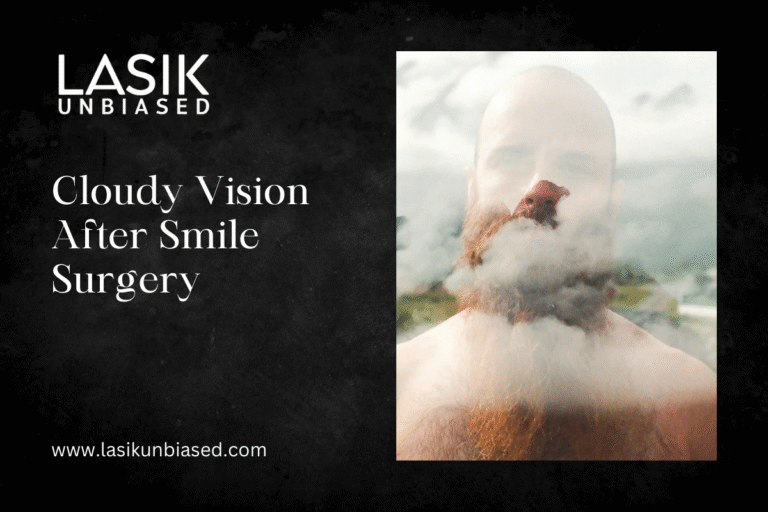Experiencing cloudy vision after SMILE surgery is a common yet temporary side effect.
It typically resolves on its own as your eyes heal, but understanding its causes and recovery timeline can provide peace of mind.
Small Incision Lenticule Extraction (SMILE) surgery is a popular minimally invasive procedure for correcting vision issues such as myopia. However, like any medical intervention, it comes with some short-term side effects, and cloudy vision is often one of them. This blog explores why it happens, what to expect, and how to manage it effectively.
What Causes Cloudy Vision After SMILE Surgery?
1. Healing Process of the Cornea
Cloudy vision can often be attributed to the natural healing process of your cornea. During the surgery, a small incision is created in the cornea to remove a thin lenticule (a disc-shaped tissue). This causes microscopic swelling and some disruption to the corneal layers, leading to blurred or hazy vision. This is normal and temporary, as your eyes undergo recovery.
2. Tear Film Instability
Post-surgery, many patients experience temporary dryness due to reduced tear production. A stable tear film is essential for clear vision, so even slight dryness can cause haziness. Artificial tears prescribed by your doctor can alleviate this issue and help maintain smooth, uninterrupted vision.
3. Epithelial Regrowth
The epithelium (the cornea’s outermost layer) undergoes mild changes following the procedure. While not directly affected by the lenticule removal, some epithelial adjustments occur as part of the healing process. This can contribute to cloudy or blurry eyesight until the corneal surface stabilises.
4. Light Sensitivity
Enhanced sensitivity to light is another post-surgery effect that can contribute to the sensation of clouded vision. Light scattering on the imperfectly healed corneal surface may add to the perception of haziness, particularly in bright or high-glare environments.
How Long Does Cloudy Vision Last?
For most patients, cloudy vision resolves within the first few days post-surgery. However, in some cases, it can persist for several weeks as the cornea gradually completes the healing process. The exact duration depends on individual healing rates, tear production, and adherence to post-operative care instructions.
Typical Recovery Milestones:
- First 48 hours: Initial discomfort and blurry vision are common as the cornea begins to heal.
- First week: Noticeable improvement in visual clarity, though mild cloudiness may linger intermittently.
- First month: Most of the haziness resolves, and vision becomes more stable.
- Three months and beyond: The cornea fully heals, and visual sharpness reaches its optimal level.
How to Manage Cloudy Vision After SMILE Surgery?
1. Follow Post-Operative Instructions
Strictly adhering to your surgeon’s aftercare guidelines is crucial for a smooth recovery. These instructions often include using prescribed eye drops, avoiding eye rubbing, and limiting activities that strain the eyes.
2. Use Artificial Tears
Dryness is a significant contributor to cloudiness post-surgery. Using preservative-free artificial tears frequently can enhance eye hydration, reducing haze and improving visual comfort.
3. Rest Your Eyes
Limiting screen time and avoiding reading or other visually intensive tasks in the first few days can prevent eye strain. Ensure you get plenty of rest to aid the healing process.
4. Wear Protective Glasses or Shields
Protective eyewear prevents accidental rubbing, exposure to irritants, and physical trauma to the healing cornea. They also protect your eyes from intense light, minimising sensitivity.
5. Address Dry Eye Symptoms
If dryness persists, your surgeon may recommend treatments like punctal plugs or lipid-based eye drops to improve tear film quality.
When to Be Concerned About Persistent Cloudiness?
Although cloudy vision is common during the healing process, it is crucial to contact your eye surgeon immediately if you notice any of the following symptoms.
- Severe or worsening vision changes after the initial week
- Persistent redness, discomfort, or swelling
- Sudden sharp eye pain
- Light flashes or severe sensitivity to light
- Any discharge from the eyes
Such symptoms could indicate complications such as corneal inflammation, epithelial ingrowth, or infection, which require timely medical intervention.
Can Cloudy Vision Be Prevented or Minimised?
Although complete prevention isn’t always possible, certain strategies can reduce the risk and severity:
- Pre-surgery Evaluation: A thorough screening ensures you’re a suitable candidate for SMILE surgery, reducing the likelihood of unexpected side effects.
- Tear Film Support: If pre-existing dryness is identified, your surgeon may recommend treatments before surgery to stabilise your tear film.
- Advanced Laser Technology: Surgeons using state-of-the-art lasers often achieve better outcomes, reducing post-surgery haziness.
- Post-Surgery Care: Being diligent with aftercare ensures your eyes heal efficiently.
Is Cloudy Vision Different From Glare or Halos?
It’s essential to distinguish cloudy vision from similar phenomena, such as glare and halos, which some patients report after SMILE surgery.
- Cloudiness: A general haze or fog over your vision, often due to surface healing or dryness.
- Glare and Halos: Light scattering effects, particularly noticeable around bright sources like car headlights. These typically lessen within a few weeks and are more related to corneal changes rather than dryness.
Understanding these differences can give you clarity about your symptoms and reassure you about their temporary nature.
The Importance of Regular Follow-Up Appointments
Post-surgery check-ups are invaluable for monitoring your recovery and addressing any concerns. These appointments allow your surgeon to:
- Assess the healing progress of your cornea
- Adjust your eye drop regimen based on tear production and lubrication needs
- Rule out any complications that could affect recovery
Keeping all scheduled follow-ups ensures any issues, no matter how minor, are managed proactively.
Trust the Recovery Process
Cloudy vision after SMILE surgery can be unsettling, but it’s reassuring to know that it’s almost always temporary and part of the healing process. Equipped with the right knowledge, you can be confident in recognising normal recovery versus potential red flags.
By following your surgeon’s advice, keeping your eyes hydrated, and attending post-operative check-ups, you’ll likely enjoy the full benefits of clear, sharp vision in no time.


